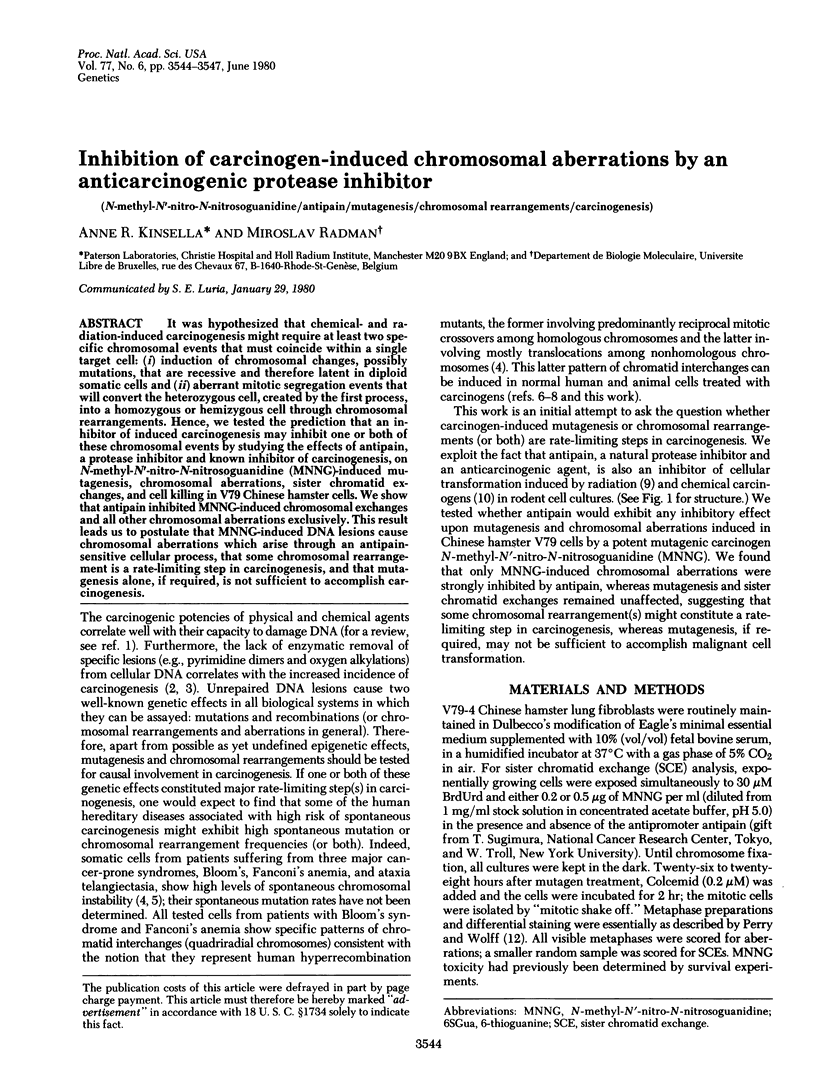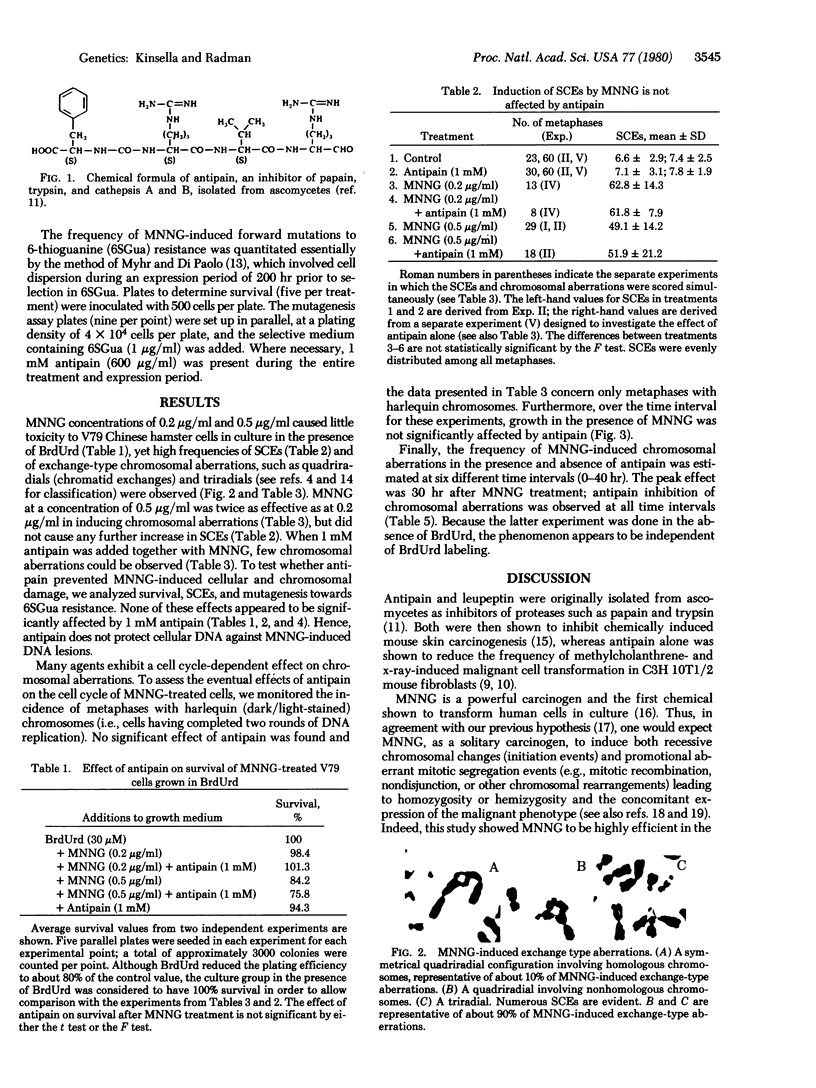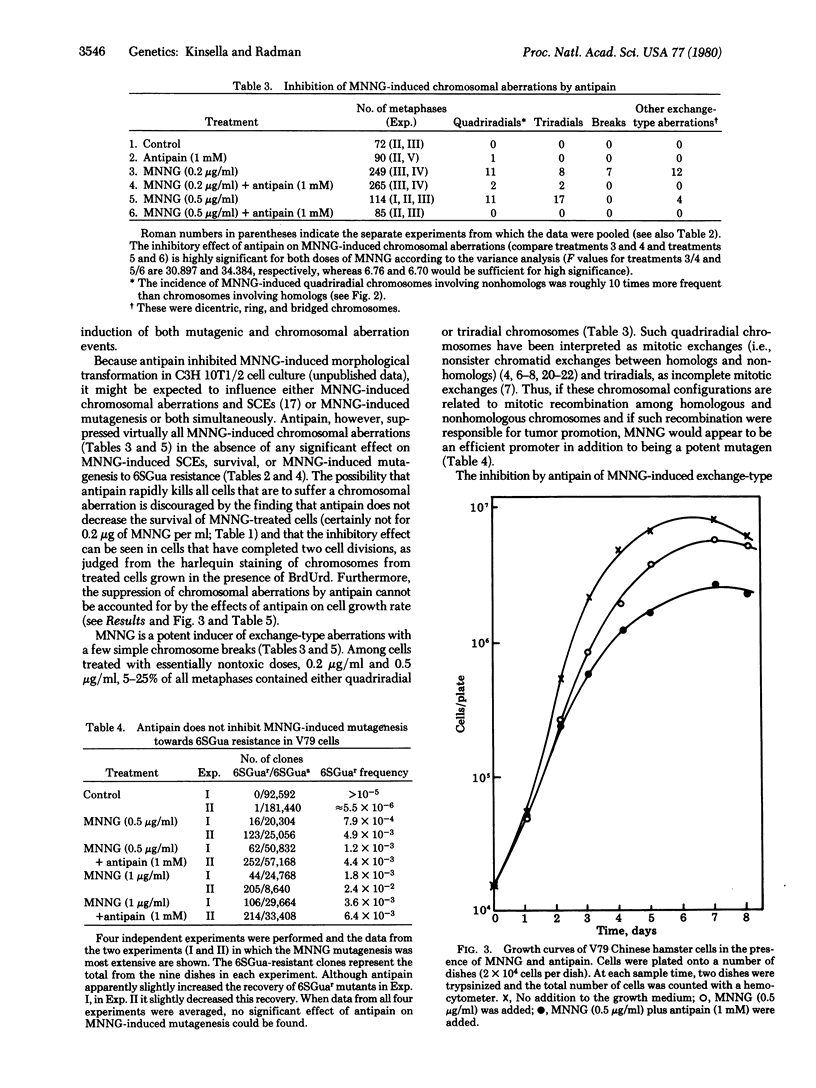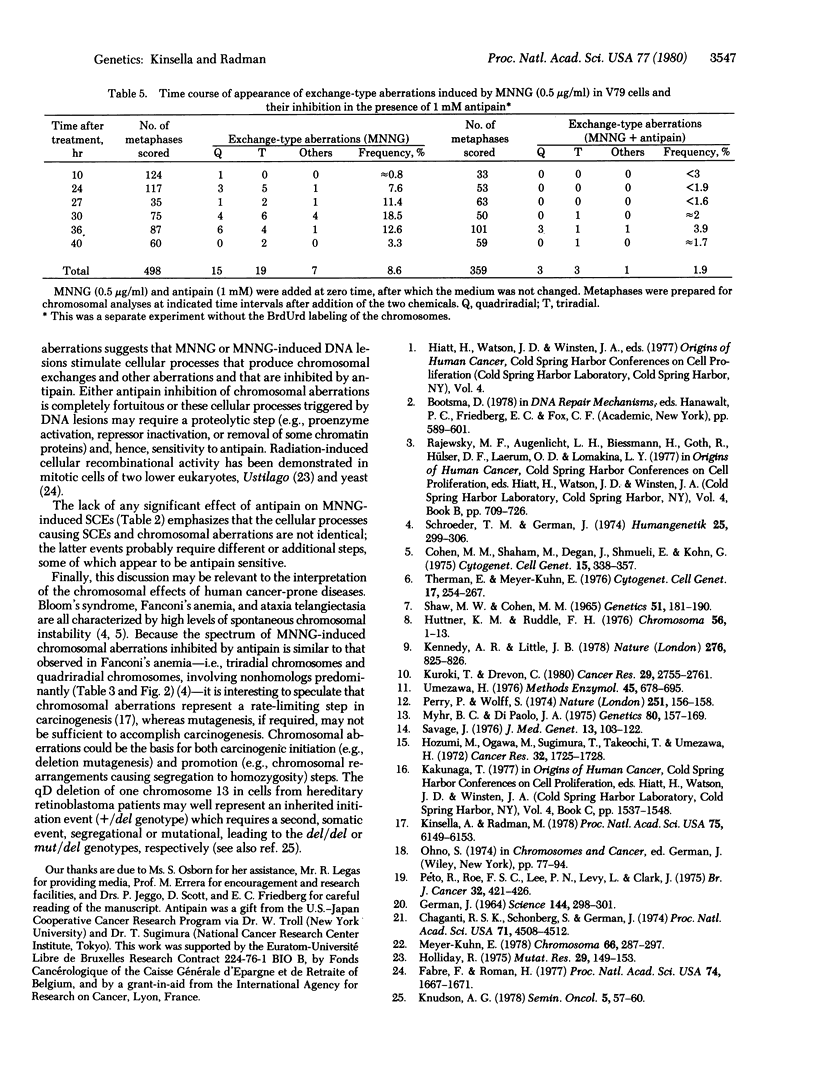Abstract
It was hypothesized that chemicals- and radiation-induced carcinogenesis might require at least two specific chromosomal events that must coincide within a single target cell: (i) induction of chromosomal changes, possibly mutations, that are recessive and therefore latent in diploid somatic cells and (ii) aberrant mitotic segregation events that will convert the heterozygous cell, created by the first process, into a homozygous or hemizygous cell through chromosomal rearrangements. Hence, we tested the prediction that an inhibitor of induced carcinogenesis may inhibit one or both of these chromosomal events by studying the effects of antipain, a protease inhibitor and known inhibitor of carcinogenesis, on N-methyl-N'-nitro-N-nitrosoguanidine (MNNG)-induced mutagenesis, chromosomal aberrations, sister chromatid exchanges, and cell killing in V79 Chinese hamster cells. We show that antipain inhibited MNNG-induced chromosomal exchanges and all other chromosomal aberrations exclusively. This results leads us to postulate that MNNG-induced DNA lesions cause chromosomal aberrations which arise through an antipain-sensitive cellular process, that some chromosomal rearrangement is a rate-limiting step in carcinogenesis, and that mutagenesis alone, if required, is not sufficient to accomplish carcinogenesis.
Full text
PDF



Images in this article
Selected References
These references are in PubMed. This may not be the complete list of references from this article.
- Chaganti R. S., Schonberg S., German J. A manyfold increase in sister chromatid exchanges in Bloom's syndrome lymphocytes. Proc Natl Acad Sci U S A. 1974 Nov;71(11):4508–4512. doi: 10.1073/pnas.71.11.4508. [DOI] [PMC free article] [PubMed] [Google Scholar]
- Cohen M. M., Shaham M., Dagan J., Shmueli E., Kohn G. Cytogenetic investigations in families with ataxia-telangiectasia. Cytogenet Cell Genet. 1975;15(5):338–356. doi: 10.1159/000130530. [DOI] [PubMed] [Google Scholar]
- Fabre F., Roman H. Genetic evidence for inducibility of recombination competence in yeast. Proc Natl Acad Sci U S A. 1977 Apr;74(4):1667–1671. doi: 10.1073/pnas.74.4.1667. [DOI] [PMC free article] [PubMed] [Google Scholar]
- GERMAN J. CYTOLOGICAL EVIDENCE FOR CROSSING-OVER IN VITRO IN HUMAN LYMPHOID CELLS. Science. 1964 Apr 17;144(3616):298–301. doi: 10.1126/science.144.3616.298. [DOI] [PubMed] [Google Scholar]
- Holliday R. Further evidence for an inducible recombination repair system in Ustilago maydis. Mutat Res. 1975 Jul;29(1):149–153. doi: 10.1016/0027-5107(75)90029-9. [DOI] [PubMed] [Google Scholar]
- Hozumi M., Ogawa M., Sugimura T., Takeuchi T., Umezawa H. Inhibition of tumorigenesis in mouse skin by leupeptin, a protease inhibitor from Actinomycetes. Cancer Res. 1972 Aug;32(8):1725–1728. [PubMed] [Google Scholar]
- Huttner K. M., Ruddle F. H. Study of mitomycin C-induced chromosomal exchange. Chromosoma. 1976 Jun 30;56(1):1–13. doi: 10.1007/BF00293724. [DOI] [PubMed] [Google Scholar]
- Kennedy A. R., Little J. B. Protease inhibitors suppress radiation-induced malignant transformation in vitro. Nature. 1978 Dec 21;276(5690):825–826. doi: 10.1038/276825a0. [DOI] [PubMed] [Google Scholar]
- Kinsella A. R., Radman M. Tumor promoter induces sister chromatid exchanges: relevance to mechanisms of carcinogenesis. Proc Natl Acad Sci U S A. 1978 Dec;75(12):6149–6153. doi: 10.1073/pnas.75.12.6149. [DOI] [PMC free article] [PubMed] [Google Scholar]
- Knudson A. G., Jr Retinoblastoma: a prototypic hereditary neoplasm. Semin Oncol. 1978 Mar;5(1):57–60. [PubMed] [Google Scholar]
- Kuhn E. M. Mitotic chiasmata and other quadriradials in mitomycin C-treated Bloom's syndrome lymphocytes. Chromosoma. 1978 Apr 25;66(3):287–297. doi: 10.1007/BF00330557. [DOI] [PubMed] [Google Scholar]
- Myhr B. C., Dipalo J. A. Requirement for cell dispersion prior to selection of induced azaguanine-resistant colonies of Chinese hamster cells. Genetics. 1975 May;80(1):157–169. doi: 10.1093/genetics/80.1.157. [DOI] [PMC free article] [PubMed] [Google Scholar]
- Perry P., Wolff S. New Giemsa method for the differential staining of sister chromatids. Nature. 1974 Sep 13;251(5471):156–158. doi: 10.1038/251156a0. [DOI] [PubMed] [Google Scholar]
- Peto R., Roe F. J., Lee P. N., Levy L., Clack J. Cancer and ageing in mice and men. Br J Cancer. 1975 Oct;32(4):411–426. doi: 10.1038/bjc.1975.242. [DOI] [PMC free article] [PubMed] [Google Scholar]
- SHAW M. W., COHEN M. M. CHROMOSOME EXCHANGES IN HUMAN LEUKOCYTES INDUCED BY MITOMYCIN C. Genetics. 1965 Feb;51:181–190. doi: 10.1093/genetics/51.2.181. [DOI] [PMC free article] [PubMed] [Google Scholar]
- Savage J. R. Classification and relationships of induced chromosomal structual changes. J Med Genet. 1976 Apr;13(2):103–122. doi: 10.1136/jmg.13.2.103. [DOI] [PMC free article] [PubMed] [Google Scholar]
- Schroeder T. M., German J. Bloom's syndrome and Fanconi's anemia: demonstration of two distinctive patterns of chromosome disruption and rearrangement. Humangenetik. 1974;25(4):299–306. doi: 10.1007/BF00336905. [DOI] [PubMed] [Google Scholar]
- Therman E., Kuhn E. M. Cytological demonstration of mitotic crossing-over in man. Cytogenet Cell Genet. 1976;17(5):254–267. doi: 10.1159/000130721. [DOI] [PubMed] [Google Scholar]
- Umezawa H. Structures and activities of protease inhibitors of microbial origin. Methods Enzymol. 1976;45:678–695. doi: 10.1016/s0076-6879(76)45058-9. [DOI] [PubMed] [Google Scholar]



